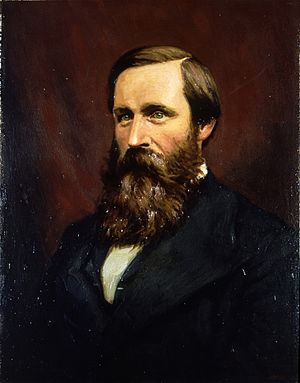William Sefton Moorhouse facts for kids
William Sefton Moorhouse (born around 1825 – died 15 September 1881) was an important politician in New Zealand. He was born in Britain and later became the second leader, or Superintendent, of the Canterbury Province. A Superintendent was like a governor for a specific region in New Zealand during that time.
Contents
Early Life and Career
William Moorhouse was born in Yorkshire, England, around December 1825. His father, William Moorhouse, was a magistrate. William trained to be a lawyer in London.
In 1851, he moved to Lyttelton, New Zealand, with his two brothers. He soon moved to Wellington and continued his law work there.
On 15 December 1853, he married Jane Ann(e) Collins in Old St. Paul's, Wellington. After a short trip to Australia, he returned to New Zealand. He lived in Lyttelton and then Christchurch. In Christchurch, he worked as a lawyer, a judge, a newspaper editor, and even owned ships!
William Moorhouse had three sisters who married well-known men. Sarah Ann married William Barnard Rhodes. Lucy Ellen Sykes married John Studholme. Mary married Thomas Henry Wigley.
William Moorhouse's Political Journey
William Moorhouse was very active in New Zealand politics. He worked both in the national government and in the local Canterbury region. He even became the Mayor of Wellington later in his life.
Serving in Parliament
Moorhouse was elected to the New Zealand Parliament many times. He first represented the Akaroa area in 1853. He continued to be a Member of Parliament (MP) until he passed away.
He represented several different areas during his time as an MP. These included Akaroa, Heathcote, Westland, Westland Boroughs, Christchurch, and Ashley.
In 1866, he won elections for two different areas, Mount Herbert and Westland. He chose to represent Westland.
Leading Canterbury Province
In 1853, William Moorhouse tried to get a seat on the Canterbury Provincial Council. He didn't win that time, but he was elected to the national Parliament instead.
In 1855, he was successfully elected to the Canterbury Provincial Council. He represented the Akaroa area.
Later, in October 1857, he became the Superintendent of Canterbury Province. This happened after the first Superintendent, James FitzGerald, resigned due to illness. Moorhouse won the election against Joseph Brittan by a large number of votes.
One of Moorhouse's biggest ideas was to build the Lyttelton Rail Tunnel. This was a very expensive and difficult project for a small colony. Other leaders thought it was too risky. But Moorhouse strongly supported it.
He served as Superintendent from 1857 to 1863. He then had another term from 1866 to 1868. After his first time as Superintendent, he continued to serve on the Provincial Council.
Later Years and Legacy
In 1875, William Moorhouse became the Mayor of Wellington. He passed away in Wellington on 15 September 1881, at about 56 years old. He had been ill with diabetes.
After a funeral in Wellington, his body was taken to Christchurch for another funeral and burial. The national Parliament stopped its work for a day to show respect for him.
He was survived by his wife, Jane, and their five children.
How William Moorhouse is Remembered
Many places in New Zealand are named after William Moorhouse.
- In 1904, a street in Christchurch was renamed Moorhouse Avenue. This street is important because it runs parallel to the railway line that leads to the tunnel he championed.
- The Moorhouse Range and Sefton Peak in the Southern Alps were named after him by Julius von Haast.
- Moorhouse and Sefton Streets in Wadestown, Wellington, also carry his name.
- A statue of William Moorhouse, created in London in 1885, stands in the Christchurch Botanic Gardens. It helps people remember his important contributions to New Zealand.
Images for kids
-
Statue of Moorhouse in the Christchurch Botanic Gardens
| Assembly seats | ||
|---|---|---|
| New constituency | Member of Parliament for Akaroa 1853–1855 1858–1860 |
Succeeded by John Cuff |
| Preceded by John Cuff |
Succeeded by Augustus White |
|
| New constituency | Member of Parliament for Mount Herbert 1866 |
Succeeded by Thomas Potts |
| Member of Parliament for Westland 1866–1868 |
Vacant
Constituency abolished, recreated in 1890
Title next held by
Richard Seddon |
|
| Preceded by William Travers |
Member of Parliament for Christchurch 1870 1875–1879 alongside: Edward Richardson, Edward Stevens |
In abeyance
Title next held by
himself |
| In abeyance
Title last held by
himself |
Succeeded by Samuel Paull Andrews |
|
| Preceded by John Evans Brown |
Member of Parliament for Ashley 1879–1881 |
Succeeded by William Fisher Pearson |
| Political offices | ||
| Preceded by James FitzGerald |
Superintendent of Canterbury Province 1857–1863 1866–1868 |
Succeeded by Samuel Bealey |
| Preceded by Samuel Bealey |
Succeeded by William Rolleston |
|
| Preceded by Charles Borlase |
Mayor of Wellington 1875 |
Succeeded by William Hutchison |



